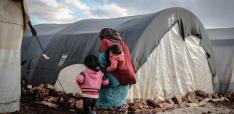20 Years of Impact of the Palermo Protocol: Contestation and Reflections

This is part of a forthcoming Global Policy e-book on modern slavery. Contributions from leading experts highlighting practical and theoretical issues surrounding the persistence of slavery, human trafficking and forced labour are being serialised here over the coming months.
“If the police or Sarkar (government) intended to increase the welfare of victims (of trafficking), they would have then provided alternative income sources or work. What they do is lock us in shelter homes or send us back to our villages. We don’t have any other option than to return back, which I also did since I needed money to sustain my livelihood”.
This is a quote from an interview which was part of my ongoing research dedicated to understanding the marginalized perspectives on anti-trafficking interventions in India. This insight was offered by Barkha (name changed for confidentiality), a cis-female migrant sex worker, who was rescued twice by India’s anti-trafficking machinery but re-joined sex work later. Barkha’s statement reveals the discontent with anti-trafficking programmes, common among the supposed beneficiaries who have been growing increasingly frustrated with the country’s policies around sex work, expressly since 2011, the year in which India ratified the United Nations’ Palermo Protocol to Prevent, Suppress, and Punish Trafficking in Persons, Especially Women and Children (later referred to as the Palermo Protocol).
2020 marked the 20th anniversary of the adoption of the Palermo Protocol, offering an opportune moment to consider the remaining contestations, review the impact on targeted populations, and assess the path forward. In her anniversary statement, Maria Grazia Giammarinaro, the United Nations’ Special Rapporteur on trafficking in persons, called for a shift away from the law enforcement approach to be achieved ‘through a rights-oriented interpretation of existing provisions of the Protocol together with the jurisprudence of regional human rights courts and soft law instruments or, potentially, through a new international instrument’. She also highlighted the negative impact of post Palermo protocol anti-trafficking policies on trafficking victims, which includes restrictive and harmful migration practices and policies. Other experts suggested replacing the Palermo Protocol with a new framework constructed primarily to ‘strengthen (other) existing international instruments focusing upon workers’ and migrants’ rights and protections’.
This criticism of the Palermo Protocol from experts in and out of the UN opens the ground to engage with the shortcomings produced by the contemporary anti-trafficking framework during its 20 years of implementation. In this article, I draw on my 2020 ethnographic field work with urban migrant sex and construction workers in Kolkata, India. My research places the epistemic priority on the lived experiences of those who are rendered as victims and become subjects of anti-trafficking interventions. This article focuses on the epistemic violence, understood as the attack on someone’s ability to speak and to be heard, which leads to harm and suffering in their lives (Spivak, 1994; Dotson, 2011; Santos, 2016), resulting from miscategorization of migrant and sex workers as trafficking victims. I argue that the Palermo Protocol enables further disenfranchisement of these groups. By denying the work agency to migrant and sex workers, these policies justify today’s morally driven anti-trafficking project and prevent meaningful rendering with the harm of modern global capitalist exploitations.
Palermo Protocol: intended impact vs reality
The modern global anti-trafficking framework is informed by the Palermo Protocol that came into force in December 2000 as part of the United Nations’ Crime Convention. Article 2 of the Palermo Protocol defines its key purposes as delivering protection and assistance to victims of trafficking, along with preventing and combatting human trafficking. Wylie wrote that, ‘Every regional governance structure in the world has assimilated the global framework (of the Palermo Protocol) into their context since 2000’. Ratified by 178 country members, the Palermo Protocol established a particular precedent for policymakers in the member states and offered the first international definition of human trafficking and the approaches to deal with it. The protocol defines human trafficking as:
“The recruitment, transportation, transfer, harboring or receipt of persons, by means of the threat or use of force or other forms of coercion, of abduction, of fraud, of deception, of the abuse of power or of a position of vulnerability or of the giving or receiving of payments or benefits to achieve the consent of a person having control over another person, for the purpose of exploitation. Exploitation shall include, at a minimum, the exploitation of the prostitution of others or other forms of sexual exploitation, forced labour or services, slavery or practices similar to slavery, servitude or the removal of organs” (UNODC, 2004: 42).
Various scholars highlighted major shortcomings in this understanding of trafficking and practices related to it. Marjan Wijers recently suggested that, ‘it's possible that the Palermo protocol did a little bit for a very small category of victims, but it did harm to much bigger groups’. Earlier, Davidson noted that,
“This definition does not actually allow us to distinguish clearly the experience of Victims of Trafficking (VoTs) from that of other groups of migrants. To begin with, the protocol frames ‘trafficking’ as a subset of ‘illegal’ immigration and as a phenomenon quite distinct from ‘smuggling’, and yet people whom states would regard as ‘smuggled’ or as ‘immigration offenders’ can also end up in the situations of exploitation listed in the protocol”.
As a result, some migrants are treated as ‘trafficked’ and sent back to the conditions they attempted to escape through migration, while others, who may well find themselves in situations of exploitation, are excluded from assistance as they do not meet the deception criteria of the trafficking definition. Nandita Sharma wrote that ‘States ‘combat trafficking’ to put a humanitarian face on their punitive anti-immigration policies. For this reason alone the project of anti-trafficking must go’. Similarly, Ayushman’s recent research in Nepal demonstrated that anti-trafficking interventions harmed migrant workers:
“They feared that accepting the label of trafficking victim subjugates them, and pushes them to embrace poverty, lowly status in the survivors’ group, and anti-trafficking borders which deny their migration via irregular channels. For the vast majority of migrants and prospective migrants, even for those categorised as trafficking victims, anti-trafficking is yet one more border to subvert and escape…...The primary problem here is not trafficking, but anti-trafficking. It creates conflict within communities and, above all, intentionally blocks the path between potential migrants and their goals”.
The Palermo Protocol definition also mis-categorizes consenting adult sex workers as victims of trafficking. The language of “the prostitution of others” does not recognize women’s autonomy in sex work in the non-presence of force or deception. Marjan Wijers, an experienced expert who contributed to the formulation of the Palermo Protocol, recently pointed out that
“the inclusion of exploitation of prostitution as a separate purpose from forced labour, etc. reinforced the historical obsession with prostitution and fed into the old conflation of trafficking and sex work and the preoccupation with the purity of women. It not only implies that sex work cannot be labour, but it also falsely suggests that forced labour cannot exist in the sex industry, consequently depriving sex workers of protection against the practice”.
The common application of the Palermo Protocol hence strips sex workers of agency to consent. Consent appeared as one of the central controversial issues during the formulation process of the Palermo Protocol and continues to be contested today. The debate around the first official definition of trafficking, developed during the second wave of feminism, mirrors the conflict between two opposing theoretical positions popular at the time: radical feminism (also identified as neo-abolitionists) and sex work feminism (also identified as critical or non-abolitionists). Radical feminists argued against the applicability and relevance of consent in the sex industry, whereas critical feminists emphasized the role of informed consent for distinguishing between sex work and trafficking. The radical influences prevailed in the discursive battle over the Palermo trafficking definition resulting in the framing of all prostitution as violation of women’s rights, regardless of whether force or deception took place.
The devaluation of consent of adult women in the sex industry is rooted in histories of paternalistic policing of women’s morality. Doezema investigates how purity campaigners in the past aimed to get rid of ‘vice’ and ‘immoral’ women through anti-trafficking discourse, highlighting the parallels with the modern anti-trafficking agenda that renders consensual sex work invisible. Truong argued that ‘the continuity of a moral panic as a common sentiment had been noted in the campaigns against White Slavery in the past and Sex Trafficking today’. These purity campaigns result in the increased pattern of criminalization of sex work, legitimizing the raid, rescue, and rehabilitation approach to anti-trafficking governance.
Criminalization is the key factor that creates precarity for sex workers. By applying the Palermo Protocol to render sex work as an inherently criminal activity, governments don't help but harm sex workers. Truong notes that,
“In the process of implementing The Protocol, several contentious issues on objectification and harm, women’s agency and choice have emerged. At one level many researchers have demonstrated how some anti-trafficking programmes have created a “rescue industry” whose practices conflate “prostitution” with “trafficking”, ending up with ascribing a victim status to people (mostly women) who have made conscious decisions to migrate…... These women are more concerned about their working environments, economic exploitation and violation of initial agreements….Some women do not consider themselves to be victims of trafficking but survivors at the margins of society.”
Experiences from India
In India, corresponding patterns of harm are recognised by scholars and target beneficiary groups alike. The amendment of section 370 of Indian Penal code in 2013 added an operational definition of human trafficking in India (Khan, 2014), resulting in the institutionalization of the UN Palermo Protocol approach and precipitation of the denial of agency to consent, criminalization, and ignored harms. In an all India Survey of Sex Worker, Pai et.al noted that,
“For sex workers, the State is an instrument of violence; feared, rather than seen as protectors of rights. The law enforcement is regarded by sex workers as the most repressive state agency. Police abuse sex workers, illegally detain, sexually assault and torture them in custody …... State actors as well as non-State actors continue to violate the rights of sex workers with impunity and there is lack of due diligence to address violence against sex workers.”
Kimberly Walters found that, ‘under India’s present anti-trafficking system, almost eight out of 10 times a woman was rescued against her will in the name of saving her from sex trafficking. That is an appallingly high rate of failure and a staggering amount of unnecessary harm’. First-hand accounts by sex workers testify to the experiences of marginalization and harm produced by this mode of anti-trafficking governance in India. For instance, a study by a collective of sex workers reported that 79% (193 out of 243) of the surveyed women responded that, at the time of the raid, they took part in sex work voluntarily and did not want to be "rescued". In the same study, a ‘rescued’ sex worker shared the following insight:
“Some have not returned from their village because they were so frightened by the way police behaved with us. They beat us, used bad words, did not allow us to meet our parents for months and did not send us home. One of my friends with whom I was arrested, was so traumatized that she died, probably due to the suffering. Sometimes we were sleeping hungry as we could not eat that uncooked and tasteless food”
My own ethnographic research reveals the patterns of victimization, selective targeting, violence, extraction of income, incarceration and other harms in the work trajectories of sex workers I interviewed. Respondents working in the sex work neighbourhood of Sonagachi in Kolkata, India shared their experiences of repeated incidences of raid, forceful rescues, physical violence exercised by the police, corruption, fear of revealing their occupation to families, and loss of livelihood. For instance, Noora (name changed) shared that,
“it (rescue operation) terrified me. We were standing in a line from 4:00 pm until 12:00 am, for 8 hours. I felt so tired and scared. That night I cried a lot and then ran away early in the morning at 5:00 am. I didn’t sleep that night. I was feeling ashamed and worried that my family might find out about me. The police took pictures of us on their phone. We tried to resist but they slapped a girl and continued to take photos of us. You know, today there is the internet and YouTube. There was also media outside. I was traumatized, fearful and worried that someone would upload my picture or video of this incident (rescue operation) on YouTube or the media or that police would reveal our identities to our families…… My family thinks that I work in a pharmacy shop in Kolkata”
Noora’s narrative reflects how criminalization exposes marginalized workers like her precarious situations and abuse of power by the police. Police act as the principal street level authority to monitor and respond to trafficking with the support of civil society, as per the law in India. 225 special Anti-Human Trafficking Units (AHTUs) were established to police sex work neighbourhoods; the police officers of AHTUs are viewed as complicit in adding harms to their lives by the target populations. For example, Barkha shares:
“You tell me why they arrest the sex workers by labelling them as a victim, and why they do not arrest trafficker. It is because they have monthly and per person settlements with traffickers. They (police) take sex workers to the police station, harass them for money and unpaid sexual services and then release them………If the police rescue a girl and also arrest a trafficker, you will find that trafficker is released in a fraction of an hour. It is because traffickers have all the ‘settlements’ with the police and legal machinery. It is the woman sex worker who has to stay in jail or pay to police to get releases. It is pity that she has to pay to get rid of this entire rescue mafia”.
My research uncovered the differences in the treatment of construction workers by the state anti-trafficking system, specifically women construction workers, as compared to sex workers in the Sonagachi sex work neighbourhood. Women employed in the construction sector whom I interviewed for my research found themselves in harsh and abusive working situations, many reported deception, wage theft, harassment, sexual exploitation, yet they were never afforded the so-called victim status or offered government help. The contrast between the treatment of sex workers and female construction workers, along with a disproportionately high share of trafficking cases in the National Crime Record Bureau registered under sex trade, highlights the arbitrary targeting of anti-trafficking interventions and raises questions about the Palermo Protocol’s true purpose. This shows that the influence of the Palermo Protocol on the Indian anti-trafficking governance failed to lead to the better protection of the marginalized workers’ human and labour rights and, instead, inflicted suffering and furthered epistemic violence.
Conclusion
Kristie Dotson defined epistemic violence as ‘a refusal, intentional or unintentional, of an audience to communicatively reciprocate a linguistic exchange owing to pernicious ignorance’, which refers to any reliable ignorance that harms another person or group of people (Dotson, 2011:238). To enact epistemic violence is to destroy the ability of a subaltern to speak and to be heard (Spivak, 1994; Dotson, 2011). The current analysis of the experiences of marginalized working class migrants and sex workers thus also demonstrated a pattern of epistemic violence in the prevailing anti-trafficking approach. Firstly, because it destroys the ability of the supposed beneficiaries to be heard and speak through the denial of their agency to consent. Secondly, as research evidence from various parts of the world and my own interviews with marginalized workers show, interventions influenced by the Palermo Protocol are viewed and experienced as harmful by the target groups, signifying a pattern of pernicious ignorance. By conflating human trafficking with sex-work and migration, the modern ant-trafficking system enables the further disenfranchisement of some of the most weak members of society.
Jaffer Latief Najar works as a PhD researcher at International Institute of Social Studies (ISS), The Hague, The Netherlands. Readers can reach him on twitter: @jafferlatief
Photo by Afzal Khan from Pexels

